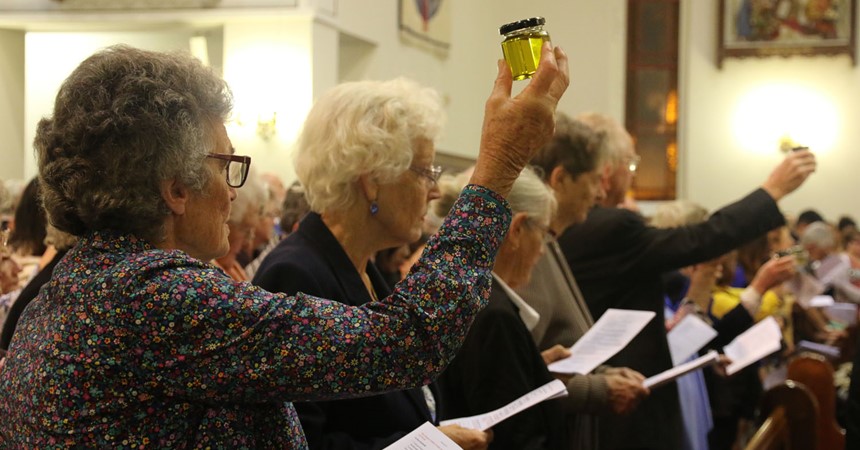This week Nick plunges us into the third and deepest level of our liturgical participation which is all about living our baptismal life and mission. Take some space and ponder what this reflection reveals to you about our liturgy, your participation and your life.
Pastoral liturgists are “keepers of the fire”: The third level of liturgical participation
by Nick Wagner
We said earlier that there are three levels of liturgical participation: what happens, what gets accomplished, and why we do what we do.
These three levels overlap, and everyone present is participating at all three levels all the time. But there can be greater and lesser degrees of participation. So, somewhat obviously, the higher the level of participation, the more effective the liturgy.
Why we celebrate the liturgy
I want to start with the third level first—the “why.” Why we celebrate the Eucharist, for example, is so that “we who are nourished by the Body and Blood of your Son and filled with his Holy Spirit may become one body, one Spirit in Christ” (Eucharistic Prayer III).
This oneness with the Divine can be said to be the “why” of any liturgy. It is not a unity that is limited to the time and place of the liturgy itself. It is a unity with a mission. At the end of the liturgy, we are dismissed (sent on mission) to unite the whole world with God. Liturgical theologian Mark Searle wrote:
Ultimately then, full, conscious, and active participation in the liturgy means nothing less than full conscious, active participation in the life of grace, lived and manifested individually and collectively as union with God and communion with all humanity.(Called to Participate: Theological, Ritual, and Social Perspectives, 38)
What cannot be conveyed here, and what is barely conveyed in the liturgy, is how utterly impossible this unity with God is. We cannot begin to imagine who God is, much less imagine what unity with God would be. It is deep mystery that is beyond our small human limitations.
Out of great love for us, however, God chooses to reveal. Throughout human history and culminating in the sending of the Son, God has pulled back the veil of mystery that separates us. Through the grace of God’s Holy Spirit, we can make out a bit of the face of God—but indistinctly, as though looking through a dark glass or a dim mirror (see 1 Cor 13:12).
Participating in the liturgy is risky
The act of liturgy is the risky action of approaching that mostly-veiled face and daring to peer more deeply into the beyond. It is a task that should inspire holy fear in our hearts (see Heb 10:31). To approach the Divine is not fearful because God is not loving. It is fearful because to know the holiness of God is to come face-to-face with our own unholiness. It is to come face-to-face with our impending death.
But our faith reminds us that in death there is life. “If we have died with Christ, we believe that we will also live with him” (Rom 6:8, NRSV).
That passage, of course is proclaimed to the catechumens just before they are buried in the font of life at their baptism. They come out of the font as new beings, having left their old selves in the water and putting on their new selves in Christ. Our new, post-baptismal identity comes with a job description. We are now charged with participating in the Priesthood of Christ, revealing God’s face to the world.
As I said, this is utterly impossible—except for the power of the Holy Spirit, in whom all things are possible.
Our participation is not only for ourselves
Where our understanding of this third level of full, conscious, and active participation gets bogged down is on an overemphasis on what happens personally to me in the liturgy. Knees bent and heads bowed we tend to focus on our own healing or transformation almost to the exclusion of everyone around us. However, the only reason I am changed in the liturgy is so that I can better participate in the transformation of the world. When we realize that and take seriously the job of our baptismal priesthood, that fear-inducing, face-gazing through the dark glass or dim mirror becomes an act of salvation:
And all of us, with unveiled faces, seeing the glory of the Lord as though reflected in a mirror, are being transformed into the same image from one degree of glory to another; for this comes from the Lord, the Spirit. (2 Cor 3:18, NRSV)
Searle concludes:
Pastoral liturgists should think of themselves as “keepers of the fire” or “guardians of the sacred threshold.” Only reverence, a profound respect for the mysteries, a deep sense of what is holy, a hunger for the true and the beautiful, can enable them to accompany others to the threshold or to keep the fire alight. (40)
We started with the “why” because having the end in mind will change how we think about what we do as “keepers of the fire.” In future posts, we’ll look at the first two levels of liturgical participation.
Source: Liturgy.Life All right reserved. Used with permission.
Back to Maitland-Newcastle
What engaged you?
What meaning does it reveal for you and us together?
What is God asking of you?

